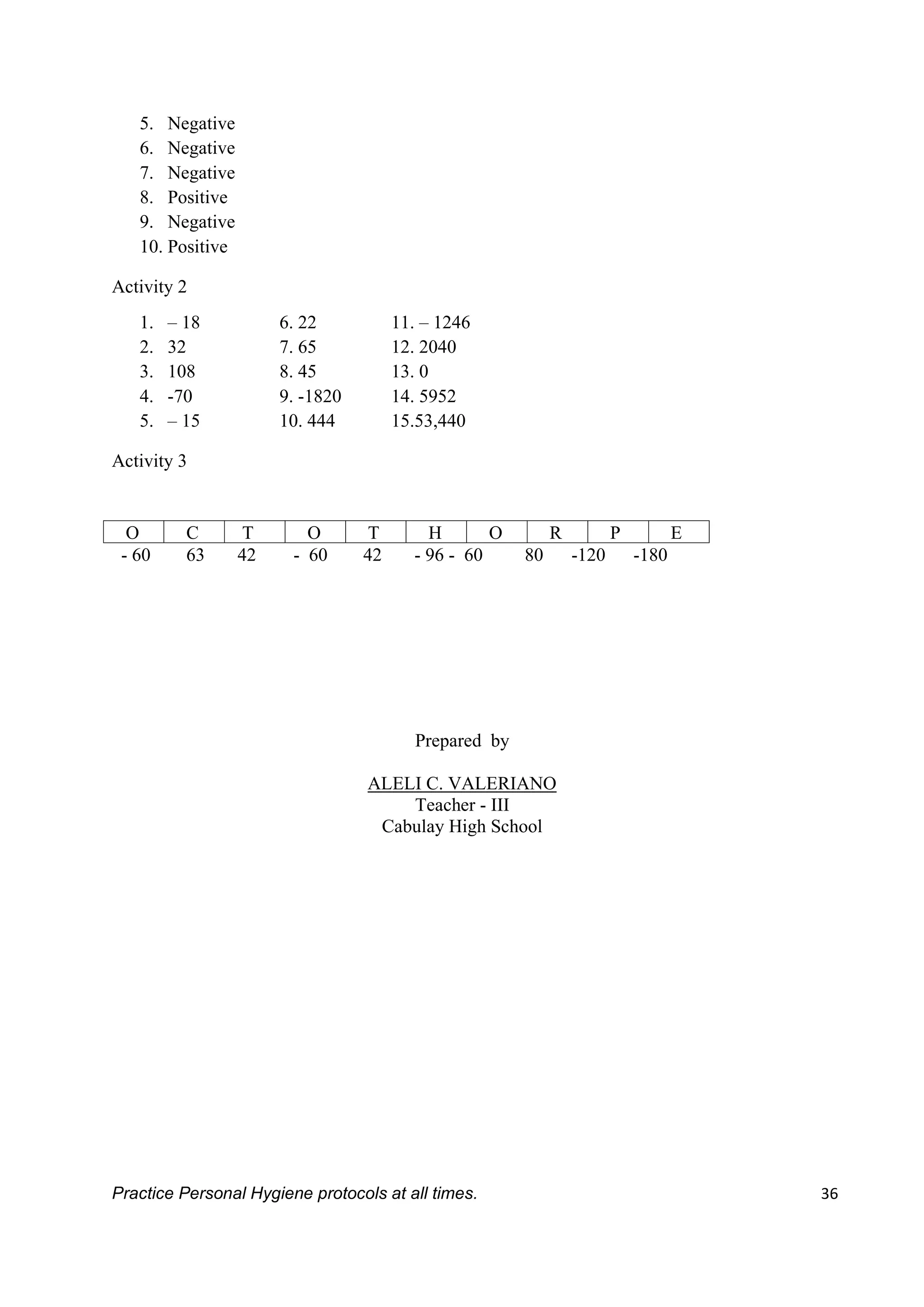The document is a Grade 7 Mathematics learning activity sheet focused on the concept of sets, including subsets, universal sets, and operations on numbers. It includes various activities aimed at helping students master these concepts and incorporates hygiene practices amidst the COVID-19 pandemic. The content is developed for educational purposes under the K to 12 curriculum by the Department of Education, Philippines.












![Practice Personal Hygiene protocols at all times. 9
This Photo by Unknown Author is licensed under CC
BY-NC-ND
4. Difference of Sets A and B
A-B = Sets of all elements in A but not in B
B-A = Sets of all elements in B but not in A
Example :
A= {4,5,6,7}, B= {1,6,7,8,9)
A-B {4,5} , B -A {1,8,9}
Example : Soaring with 95%
In a class of 40 students ;
25 got an average of 95 in English ;
17 have an average of 95 in Mathematics ,
7 have an average of 95 in Mathematics and English
U = 40
English Mathematics
18 7 10
5
a. How many students have an average of 95 in English only?
b. How many students have an average of 95 in Math Only?
c. How many student do not have an average of 95 in Math and English?
Solution :
a. For Students who have an average of 95 in English only
25-7 = 18 students have an average 95 in English only
b. For Students who have an average of 95 in Math only
17-7 = 10 students have an average of 95 in Math only
c. Students that does not have an average of 95 in both English and Math
40 - [18 +7 +10 ] = 5 students does not have an average of 95 in both Math and
Science
Learning Competency (Quarter 1, Week 2)
Solve problems involving sets with the use of Venn Diagram. (M7NS-Ib-2)](https://image.slidesharecdn.com/grade7mathematicsfinal-240520063610-77aee411/75/Grade-7-Mathematics-Final-pdf-learning-a-13-2048.jpg)








![Practice Personal Hygiene protocols at all times. 18
References
A. Books
1. Orance, O. and Mendoza, M., 2015. E- Math 7. 1st ed. 586 Nicanor Reyes St.,
Sampaloc Manila: Rex Book Store, pp.35-38.
2. De Leon, C. and Bernabe, J., 2002. Elementary Algebra. 1281 Gregorio Araneta
Avenue, Quezon City: JTW Corporation, pp.32-33.
3. 2013. Mathematics Grade 7 Teacher's Guide. 1st ed. 2nd Floor Dorm G, Philsports
Complex, Meralco Avenue, Pasig City, Philippines 1600: Department of Education,
pp.94-100.
4. Aseron, E., Armas, A., Canonigo, A. and Garces, I., 2013. Mathematics – Grade 7
Learner’S Material. 1st ed. 2nd Floor Dorm G, Philsports Complex, Meralco Avenue,
Pasig City, Philippines 1600: Department of Education, pp.70-75.
B. Website
1. Arias, L., 2019. Positive And Negative Numbers, Oh My!. [online] Google Books.
Available at: <https://books.google.com.ph/books?id=TQ-
XDwAAQBAJ&printsec=frontcover&dq=absolute+value+of+a+number&hl=en&sa=
X&ved=0ahUKEwim09GS_cvpAhWuBKYKHd_bB94Q6AEIJjAA#v=onepage&q=a
bsolute%20value%20of%20a%20number&f=false> [Accessed 24 May 2020].
2. Kolby, J., 2020. ACT Math Prep Course. [online] Google Books. Available at:
<https://books.google.com.ph/books?id=NQ_CBgAAQBAJ&pg=PA131&dq=absolut
e+value+of+a+number&hl=en&sa=X&ved=0ahUKEwim09GS_cvpAhWuBKYKHd
_bB94Q6AEIdzAJ#v=onepage&q=absolute%20value%20of%20a%20number&f=fal
se> [Accessed 20 May 2020].
3. Aufmann, R. and Lockwood, J., 2020. Course Companion For Basic College
Mathematics: Powered By Enhanced Webassign. [online] Google Books. Available
at: <https://books.google.com.ph/books?id=BoXbkVg325sC&pg=RA3-
4. Marshall, S., n.d. Rubric For Short-Answer Math Problems. [online]
Hosting.astro.cornell.edu.Available at:
<http://hosting.astro.cornell.edu/~seanm/Sean_Marshall_rubrics.pdf> [Accessed 20
May 2020].
Others:
1. STARBOOKS. 2020. Absolute Value of A Number.
2. Word Search
3. Google Map](https://image.slidesharecdn.com/grade7mathematicsfinal-240520063610-77aee411/75/Grade-7-Mathematics-Final-pdf-learning-a-22-2048.jpg)































































































![Practice Personal Hygiene protocols at all times. 114
Answer Key
Activity 1
I.
1. +30
2. -3
3.-2
4. +5
5. +500
II.
1. Representation:1500 – [(8x39) + (5x55) + (7x39) + (5 x30)]
Solution: 1500 – [(8x39) + (5x55) + (7x39) + (5 x30)]
= 1500 – (312 + 275 + 273 + 150)
= 1500 – 1010 = 490
Therefore, his change is Php 490
2. Representation: 35 – 8 + 1 = number of years she’s planting trees
12 x number of years she’s planting trees = no of trees
Solution: 12 x (35 – 8 + 1)
= 12 x 28
= 336
Therefore, Josefa planted 336 trees in 28 years
3. Representation: 500 x 3500
Solution: 500 x 3500
= 1 750 000
Therefore, 500 square meter worth Php 1, 750, 000 .00
Activity 2
I.
Representation Opposite
1.10 -10
2. -2 +2
3. +5 -5
4. -21000 +21,000
5. +30 -30
II. Example of expected answers. The answers of this activity varies.
1. The water level increase 21 cubic meters
2. The electric power plant experience power lost of 15 kw every day
3. The gross monthly income of Robinsons dropped to 32%.
4. Maria is in the 70th
floor and she moves down 13 floors.
5. She moves up 7 steps.
III.
1. B. Erbium - 5000.00
2. D. Californium 3.78 𝑥108
3. C. Europmium 500
Time to CHECK](https://image.slidesharecdn.com/grade7mathematicsfinal-240520063610-77aee411/75/Grade-7-Mathematics-Final-pdf-learning-a-118-2048.jpg)
